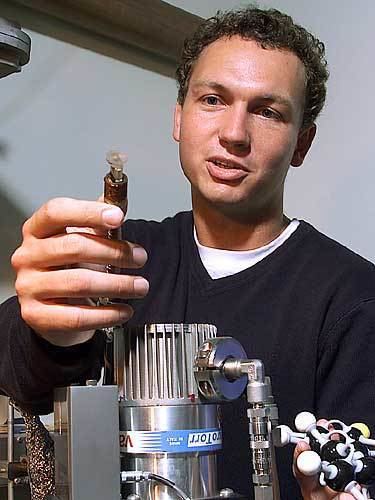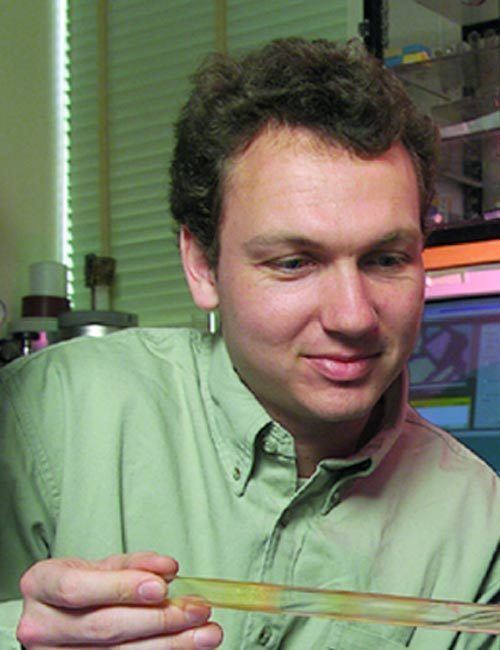Name Schon scandal Role Physicist | ||
 | ||
The Schön scandal concerns German physicist Jan Hendrik Schön (born August 1970 in Verden an der Aller, Lower Saxony, Germany) who briefly rose to prominence after a series of apparent breakthroughs with semiconductors that were later discovered to be fraudulent. Before he was exposed, Schön had received the Otto-Klung-Weberbank Prize for Physics and the Braunschweig Prize in 2001 as well as the Outstanding Young Investigator Award of the Materials Research Society in 2002, both of which were later rescinded.
Contents
- Rise to prominence
- Allegations and investigation
- Aftermath and sanctions
- Withdrawn journal papers
- Further questionable journal articles
- References

The scandal provoked discussion in the scientific community about the degree of responsibility of coauthors and reviewers of scientific papers. The debate centered on whether peer review, traditionally designed to find errors and determine relevance and originality of papers, should also be required to detect deliberate fraud.
Rise to prominence
Schön's field of research was condensed matter physics and nanotechnology. He received his PhD from the University of Konstanz in 1997. In late 1997 he was hired by Bell Labs, located in New Jersey, United States. There, he worked on electronics in which conventional semiconducting elements (such as silicon) were replaced by crystalline organic materials. Specific organic materials can conduct electrical currents, and in a so-called field-effect transistor (a refined implementation of the transistor effect, which was pioneered in 1947 in the same laboratory) the conductance can be switched on or off, a basic function in the field of electronics. Schön, however, claimed spectacular on/off behavior, far beyond anything achieved thus far with organic materials. His measurements in most cases confirmed various theoretical predictions, for example that the organic materials could be made to display superconductivity or be used in lasers. The findings were published in prominent scientific publications, including the journals Science and Nature, and gained worldwide attention. However, no research group anywhere in the world succeeded in reproducing the results claimed by Schön.
In 2001 he was listed as an author on an average of one newly published research paper every eight days. In that year he announced in Nature that he had produced a transistor on the molecular scale. Schön claimed to have used a thin layer of organic dye molecules to assemble an electric circuit that, when acted on by an electric current, behaved as a transistor. The implications of his work were significant. It would have been the beginning of a move away from silicon-based electronics and towards organic electronics. It would have allowed chips to continue shrinking past the point at which silicon breaks down, and therefore continue Moore's Law for much longer than is currently predicted. It also would have drastically reduced the cost of electronics.
A key element in Schön's claimed successful observation of various physical phenomena in organic materials was in the transistor setup, specifically, a thin layer of aluminium oxide which Schön incorporated in the transistors using lab-facilities of the University of Konstanz in Germany. Although the equipment and materials used were commonly used by laboratories all over the world, no one succeeded in preparing aluminium oxide layers of similar quality as claimed by Schön.
Allegations and investigation
As recounted by Dan Agin in his book Junk Science, soon after Schön published his work on single-molecule semiconductors, others in the physics community alleged that his data contained anomalies. Lydia Sohn, then of Princeton University, noticed that two experiments carried out at very different temperatures had identical noise. When the editors of Nature pointed this out to Schön, he claimed to have accidentally submitted the same graph twice. Paul McEuen of Cornell University then found the same noise in a paper describing a third experiment. More research by McEuen, Sohn, and other physicists uncovered a number of examples of duplicate data in Schön's work. This triggered a series of reactions that quickly led Lucent Technologies (which ran Bell Labs) to start a formal investigation.
In May 2002, Bell Labs set up a committee to investigate, with Malcolm Beasley of Stanford University as chair. The committee obtained information from all of Schön's coauthors, and interviewed the three principal ones (Zhenan Bao, Bertram Batlogg and Christian Kloc). It examined electronic drafts of the disputed papers which included processed numeric data. The committee requested copies of the raw data but found that Schön had kept no laboratory notebooks. His raw-data files had been erased from his computer. According to Schön, the files were erased because his computer had limited hard drive space. In addition, all of his experimental samples had been discarded, or damaged beyond repair.
On September 25, 2002, the committee publicly released its report. The report contained details of 24 allegations of misconduct. They found evidence of Schön's scientific misconduct in at least 16 of them. They found that whole data sets had been reused in a number of different "experiments." They also found that some of his graphs, which purportedly had been plotted from experimental data, had instead been produced using mathematical functions.
The report found that all of the misdeeds had been performed by Schön alone. All of the coauthors (including Bertram Batlogg, who was the head of the team) were exonerated of scientific misconduct. This sparked widespread debate in the scientific community on how the blame for misconduct should be shared among co-authors, particularly when they share a significant part of the credit.
Aftermath and sanctions
Schön acknowledged that the data were incorrect in many of these papers. He claimed that the substitutions could have occurred by honest mistake. He admitted to having falsified some data and stated he did so to show more convincing evidence for behaviour that he observed.
Experimenters at Delft University of Technology and the Thomas J. Watson Research Center have since performed experiments similar to Schön's, without achieving similar results. Even before the allegations had become public, several research groups had tried to reproduce most of his spectacular results in the field of the physics of organic molecular materials without success.
Schön returned to Germany and took a job at an engineering firm. In June 2004 the University of Konstanz issued a press release stating that Schön's doctoral degree had been revoked due to "dishonourable conduct". Department of Physics spokesman Wolfgang Dieterich called the affair the "biggest fraud in physics in the last 50 years" and said that the "credibility of science had been brought into disrepute". Schön appealed the ruling, but on October 28, 2009 it was upheld by the University. In response, Schön sued the University, and appeared in court to testify on September 23, 2010. The court overturned the University's decision on September 27, 2010. However, in November 2010 the University moved to appeal the court's ruling. The state court ruled in September 2011 that the university was correct in revoking his doctorate. The Federal Administrative Court upheld the state court's decision in July 2013, and the Federal Constitutional Court confirmed it in September 2014.
In the meantime, in October 2004, the Deutsche Forschungsgemeinschaft (DFG, the German Research Foundation) Joint Committee announced sanctions against him. The former DFG post-doctorate fellow was deprived of his active right to vote in DFG elections or serve on DFG committees for an eight-year period. During that period, Schön will also be unable to serve as a peer reviewer or apply for DFG funds.
Withdrawn journal papers
On October 31, 2002, Science withdrew eight papers written by Schön:
On December 20, 2002, Physical Review withdrew six papers written by Schön:
On February 24, 2003, Applied Physics Letters withdrew four papers written by Schön:
On May 2, 2003, Science withdrew another paper written by Schön:
On March 20, 2003, Advanced Materials withdrew two papers written by Schön:
On March 5, 2003, Nature withdrew seven papers written by Schön:
Further questionable journal articles
The retraction notices from February 24, 2003 in Applied Physics Letters relayed concerns about seven papers written by Schön and published in the Applied Physics Letters:
The retraction notice from March 20, 2003 in Advanced Materials mentions concerns about another paper written by Schön:
